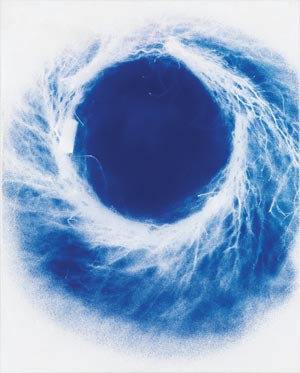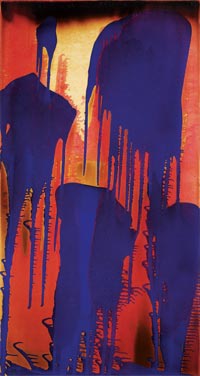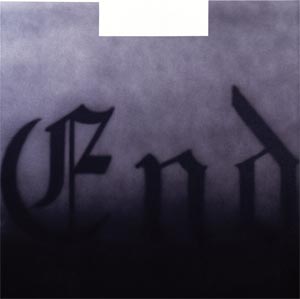‘The Show is Over’, Gagosian’s ‘death of painting’ exhibition

Simply sign up to the Life & Arts myFT Digest -- delivered directly to your inbox.
Can you paint the end of painting? No: by painting the death of painting, you keep painting alive. But yes: a tradition built up around the theme is already a century old. Works in this lineage tend to be cold, cerebral, clever and – surprisingly for an art of endgame – continually evolving. They have done so since Malevich’s “Black Square” (1915), icon of the Bolshevik revolution, found its true heirs in New York abstraction of the cold war era, and then beyond – among late 20th- and early 21st-century conceptual painters animated by scepticism of their medium.
It is hard to imagine a British museum tackling this difficult, unfinished story. Gagosian Gallery, however, in its unofficial role as ambassador of American art abroad, has episodically been threading together such a narrative in the decade since it opened its London spaces. Following Imageless Icons: Abstract Thoughts (2005) and Crash! (2010), next week it launches The Show Is Over.
A smart exhibition focused, though not exclusively, on American painters, it spans several generations – from Robert Ryman (a 1960s series exploring the limits of white pigment and grey paint on aluminium) and Ed Ruscha (the deadpan 1980s “Hourglass” and “End”, the word written in Gothic script on a smoky black canvas) to fashionable young New Yorkers. Thus Wade Guyton’s grey ink-jet manipulations and Nate Lowman’s dirt, sugar and dental floss collages “Joe Dirt” and “Down on Your Luck” demonstrate artists born in the 1970s still battling the legacies of Pollock and Warhol. The ambitious range, and an installation at once sober and glamorous, is surely aimed to flatter the discernment of the Frieze crowd. While the historical scope enlightens, the show embodies the closed systems of thought and self-reference that can make the art world so maddening.
The earliest American works are the 1951 “White Paintings” with which Robert Rauschenberg set out to reduce painting to its essence. Are they blanks, redolent of fear of nothingness, cold war annihilation, loss of meaning? Or are they, as John Cage argued, tuned reflective screens – “airports for the lights, shadows and particles” of everyday democratic existence? Like Malevich’s monochromes, you could read them as revolutionary beginnings – bare templates awaiting America’s postwar triumph – or finales to painterly possibility.

European slash-and-burn paintings of this epoch here are by contrast materially destructive: Lucio Fontana’s ripped canvas “Concetto spaziale, Attese”, Yves Klein’s scorched cardboard “Fire Painting” series. And then came the high priest of European gloom, Gerhard Richter, represented by a pair of dead-end “Grau (Grey)” canvases from the 1970s, and a mirror.
Richter is installed to face a huge new canvas by Rudolf Stingel. “Untitled (Ernst Ludwig Kirchner)” overlays the remnant of a portrait depicting the German expressionist painter with Stingel’s spare yet opulent patterning, redolent of peeling brocade, fragmented oriental rugs. The play with surface and representation is distancing, austere; motifs vanish into emptiness, but the disquieting painterly effects call for close attention.
Stingel, born in Italy but now a New York painter, is a current art market darling – his latest solo show is an installation entirely filling François Pinault’s Palazzo Grassi in Venice. Stingel combines American cool and easy monumentality with an undertow of European restlessness – a friction that resonates in the exhibition.
For nihilism is a European not an American invention. Gagosian’s title comes from Vasily Rozanov’s essay “The Apocalypse of Our Time”, written just before the philosopher starved to death in 1919. “With a clang, a creak and a scream the iron curtain drops on Russian history,” Rozanov predicted. “The show is over. The audience get up to leave their seats. Time to collect their coats and go home. They turn round. No more coats and no more home.”

In 1967 Belgian situationist Raoul Vaneigem declared Rozanov’s the “perfect” definition of nihilism, and from there the Russian’s writing permeated western (counter-)culture. In 1990 Christopher Wool took the whole five-sentence “The show is over” quotation, reorganised the words into a hard-to-read grid system and stencilled the letters in black enamel on to a three-metre aluminium panel. A later collaboration with Félix González-Torres saw Wool’s celebrated text painting reproduced as a poster in infinite numbers, to be given away – as González-Torres famously did with piles of sweets – to visitors at an exhibition. González-Torres presumably intended the diminishing heaps as a metaphor for the process of dying; he died of Aids in 1996. The posters will be handed out freely at Britannia Street: nihilism as a party bag memento of Frieze Week.
Graciously laid out in Gagosian’s towering galleries, The Show Is Over is a textbook case of how a top commercial gallery combines subversion with business to maintain freshness and market edge. These galleries are astonishingly skilled at co-opting an art of process such as that of González-Torres into a product; they also, as here, riff on themselves as they do it.
Museums rarely enjoy such playful freedoms. Commercial spaces move faster, too, responding globally to rising reputations – Jeff Elrod’s computer-generated UV ink abstraction “Echo Painting” (2013), for instance, introduces to British audiences the signature post-Richter grisaille blur of an increasingly acclaimed New York artist. And Gagosian installs with luxuriant abandon – an enormous room here is occupied solely by two Richard Serra black drawings, one a paintstick-on-linen “Left Corner Horizontal”, displayed like a sculpture jutted into a wall, in dialogue with a quartet of reflective Robert Rymans.
On the other hand Gagosian is always weighed down, to a greater or lesser extent, by expensive, dull, conceptual packaging – the well-rehearsed strategies of Dan Colen’s metallic stud painting “Second Coming”, Adam McEwen’s chewing gum canvases and “Image Coming Soon” text works, and many others here.
This is a courageously inconclusive show about conclusions in painting. But most compelling is its intellectual paradox – nihilism for sale.
‘The Show Is Over’, Gagosian Gallery, London, October 15-November 30, www.gagosian.com
Comments